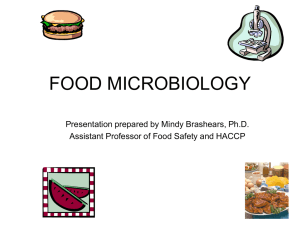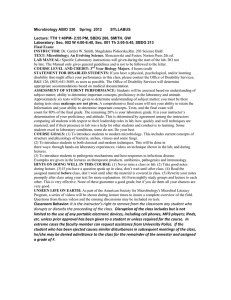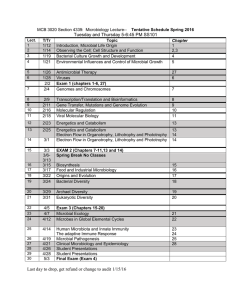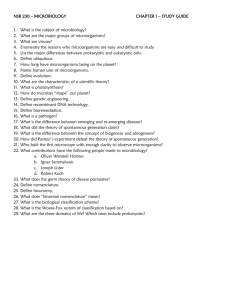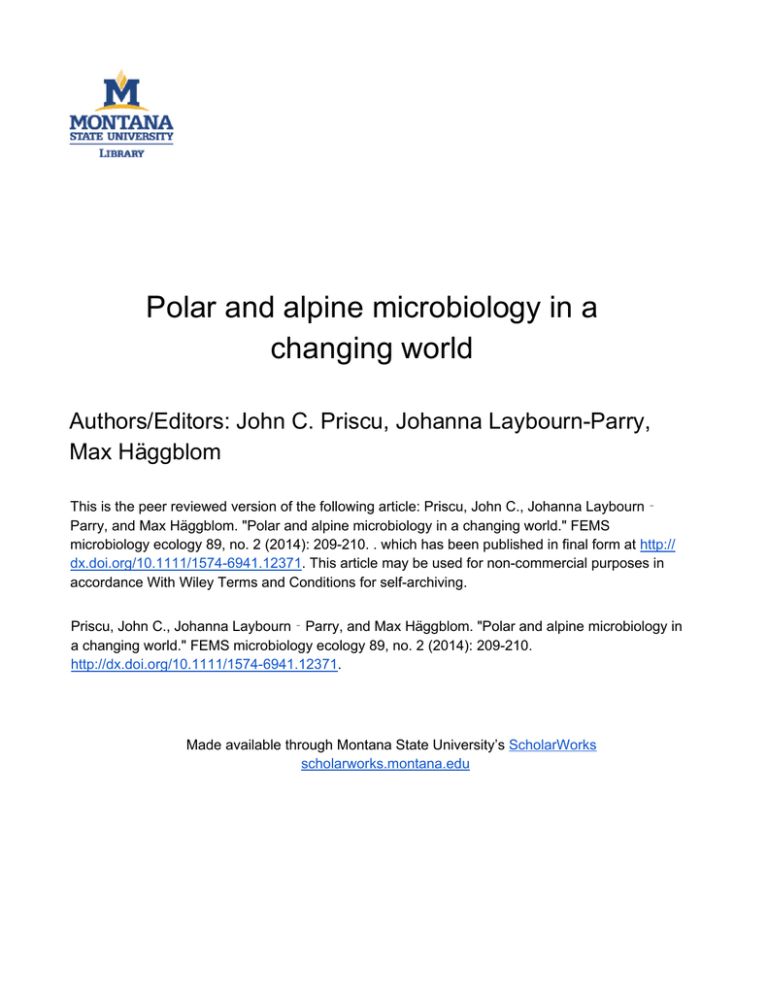
Polar and alpine microbiology in a
changing world Authors/Editors: John C. Priscu, Johanna Laybourn-Parry,
Max Häggblom This is the peer reviewed version of the following article: Priscu, John C., Johanna Laybourn‐
Parry, and Max Häggblom. "Polar and alpine microbiology in a changing world." FEMS
microbiology ecology 89, no. 2 (2014): 209-210. . which has been published in final form at http://
dx.doi.org/10.1111/1574-6941.12371. This article may be used for non-commercial purposes in
accordance With Wiley Terms and Conditions for self-archiving. Priscu, John C., Johanna Laybourn‐Parry, and Max Häggblom. "Polar and alpine microbiology in
a changing world." FEMS microbiology ecology 89, no. 2 (2014): 209-210.
http://dx.doi.org/10.1111/1574-6941.12371.
Made available through Montana State University’s ScholarWorks scholarworks.montana.edu Polar and alpine microbiology in a changing
world
John C. Priscu (Issue Editor):
Department of Land Resources and Environmental Science
Montana State University
Bozeman, MT, USA
e-mail: jpriscu@montana.edu
Johanna Laybourn-Parry (Issue Editor):
School of Geographical Sciences
University of Bristol
Bristol, UK,
e-mail: jo.laybourn-parry@bristol.ac.uk
High altitude and high latitude regions on Earth are
experiencing rapid changes in climate. Ecological impacts
resulting from these changes are now being observed at
all ecosystem levels and larger deviations and more significant impacts are anticipated in the future. Satellite data
show dramatic reductions in the extent and thickness of
sea ice at both poles, and rising temperatures are causing
alpine glaciers worldwide to shrink in area and volume.
By virtue of their relatively rapid growth rates and metabolic diversity, we can expect microorganisms to be the
first responders to fluctuating climatic conditions. Because
microorganisms are keystone players in elemental transformations, variations in their abundance and diversity
will initiate a cascade of impacts throughout entire ecosystems. Clearly, knowledge of the distribution, biodiversity and functional roles of microorganisms inhabiting
polar and alpine environments is essential to our understanding of ecosystem processes in a changing climate.
The continued warming and diminishing extent of the
polar and alpine cryosphere will be a major driver of the
microbially mediated processes occurring in these environments. We can expect to see changes in biodiversity,
ecosystem and organismal stoichiometry, amplification of
certain trophic levels, and a change in genomic connectivity among ecosystem components as the result of a warming cryosphere. Eventually, the climate-driven changes
occurring in polar and alpine systems will reach critical
thresholds or tipping points, if they have not already, that
will bring them into a new state or level of activity.
Consequently, it is imperative that we identify key connections and feedbacks resulting from the interactions
between the global climate system and the microbial
ecosystems that inhabit Earth’s cryosphere. Particularly
important is our understanding of the genetic, taxonomic,
and functional aspects of microbial biodiversity in a
changing world. There is a need for a holistic, interdisciplinary systems approach to the microbiology of polar
and alpine regions if we are to truly identify microbial
responses to climate change.
Understanding the adaptability of microorganisms on
Earth to changing climate will also provide us with
important insights in our search for microbial life beyond
Earth. Given that life has been microscopic throughout
most of Earth’s history and even today microorganisms
dominate our planet in the most diverse and extreme
Max Haggblom (Chief Editor):
Department of Biochemistry and Microbiology
Rutgers University
New Brunswick, NJ, USA
e-mail: haggblom@aesop.rutgers.edu
environments, it is reasonable to presume that if life
exists beyond Earth, it most likely would have started as
prokaryotic microorganisms and may still remain in this
stage of evolution today. As our active exploration of
space begins its sixth decade, we have, for the first time
in the history of humanity, the tools and techniques to
probe the profound question of microbial habitability on
worlds beyond Earth. The icy moons of the outer Solar
System, worlds like Europa and Enceladus that orbit Jupiter and Saturn, respectively, are covered by ice and harbor subsurface liquid water oceans that contain many
times the volume of liquid water found on Earth. These
oceans are there today and have probably persisted for
much of the history of the solar system making them
ideal environments in which to search for microbial life
beyond Earth and which to examine a possible second,
independent origin of life. If microbial life were discovered on the icy worlds of our outer solar system, we
could then begin a rigorous cross-comparison to investigate the conditions leading to the emergence of life on
both worlds and to the role that the cryosphere has in
the evolution of these microorganisms.
These are indeed exciting times to be a microbial ecologist. An understanding of contemporary dynamics of
microorganisms on our planet, and possibly elsewhere,
will provide us with the background necessary to understand the complex interactions that will occur as climate
changes in our polar and alpine regions. New and emerging technologies in the field of genomics will allow us to
study the structure, content, and evolution of genomes
including the analysis of the expression and function of
both gene and proteins. Next generation sequencing in
concert with new developments in bioinformatics will
allow genomic data to be converted into a format that
can be included in ecosystem models that address evolution, diversity, biogeography, biogeochemistry, and metabolic capacity in response to environmental change. When
coupled with remote sensing, in situ instrumentation, and
long-term observatories, genomic data from specific cryospheric environments can be used to evaluate ongoing
and potential impacts of polar and alpine climate forcing
on all of the ecosystems on Earth, including the interconnectivity they have with humans. The global impact of
rapidly changing climate make polar and alpine environments a fundamental concern for science and society.
Advances in our understanding of the microbiology of
polar and alpine environments have been presented and
discussed through a series of conferences focusing on
polar and alpine microbiology. The first Polar and Alpine
Microbiology Conference was held in Rovaniemi, Finland
in 2004. Subsequent conferences were in Innsbruck, Austria (2006), Banff, Canada (2008), Ljubljana, Slovenia
(2011) and the latest one Big Sky, Montana (2013). These
conferences have provided a multidisciplinary forum to
explore emerging areas in the field, and provide opportunities for the exchange of ideas and building of collaborations. The undeniable realization that polar and alpine
environments are being influenced significantly and perhaps irreversibly by rapid climate change led us to the
theme for the Big Sky conference: ‘Discovery in a Changing World’. The Big Sky conference brought together
more than 140 international researchers and included 54
oral presentations and 70 posters. Following an opening
lecture that focused on more than 20 years of ecosystem
response in Antarctic marine waters, the conference was
divided into seven sessions. The first three sessions
focused on linking the polar and alpine cryosphere to
other ecosystems, identifying first responders to climate
change, and addressing potential thresholds and tipping
points in the microbial world related to change. Sessions
four and five addressed the emerging field of subglacial
microbiology and examined the evolution of psychrophilic microorganisms. Session six focused on biodiversity, ecosystem function and environmental change in the
past, present, and future, and Session seven took us
beyond earth to discuss potential microbial life on other
icy worlds using Earth’s subzero biosphere as a model
system.
This thematic issue of FEMS Microbiology Ecology
includes 22 peer-reviewed manuscripts based on presenta-
ª 2014 Federation of European Microbiological Societies.
Published by John Wiley & Sons Ltd. All rights reserved
tions given at the 2013 Big Sky Conference as well as
other submissions received. The manuscripts present new
information on the distribution, biodiversity and functional role of microorganisms in marine, freshwater,
terrestrial, and glacial environments from high latitude
and high altitude environments, all of which are being
impacted significantly by climate warming. Collectively,
the information contained in these manuscripts reveals
that not all of the details fit in perfectly; if they did we
would have to question the biocomplexity of the microbial world. The information does provide a new baseline
from which to launch future research efforts and make
new discoveries in our changing world.
FEMS Microbiol Ecol 89 (2014) 209–210


